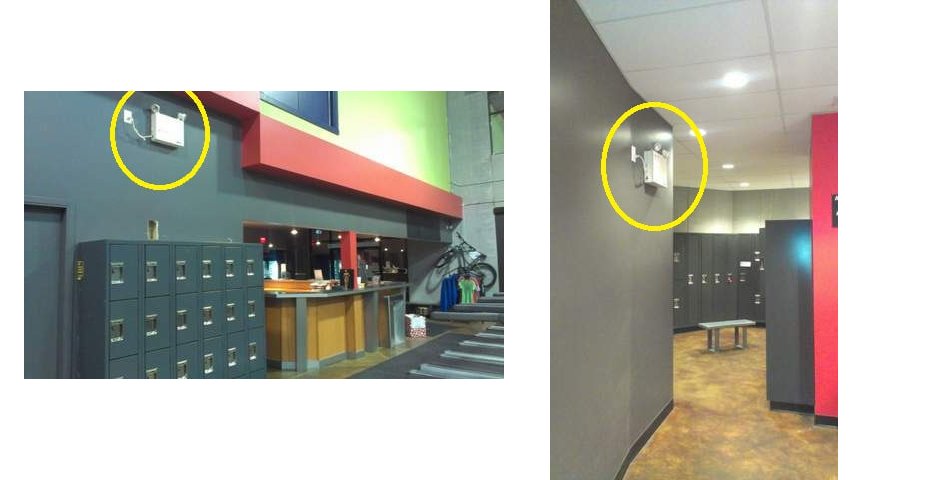Do You Need Emergency Lights for 2 Family
Emergency Lighting Systems for Buildings
Emergency lighting systems in buildings are rarely used, but are critical if needed. When the master ability goes out, these units provide calorie-free to a safe passage. When the fire alarm bells are ringing and smoke is in the air, these backup lights salve lives by helping to preclude people from panicking.
Emergency lighting is a role of a building's life safety organization, and are standard in commercial, industrial and multi-family residential buildings. Emergency lighting activates when the main ability is cut by fire; it provides illumination for a minimum of 30 minutes to allow the edifice to be evacuated.

Nearly times, the emergency lights are split up from exit signs, and their purpose is to:
- Illuminate the path along the exit routes, especially in hallways, office spaces and floor spaces with high occupancy levels;
- Provide a minimum level of lighting in the nearly populated areas of the edifice;
- Highlight equipment hazards and falling hazards such every bit stairways;
- Keep people calm when the master lights go out;
- Emphasize muster areas as people instinctively 'head towards the light' during a crunch.
Emergency lighting is required in high-occupancy residential buildings. The individual suites don't need emergency lamps, only the common areas, corridors and stairwells do.
Emergency lights are powered by a bombardment-backup organization that switch on automatically in a power outage. Remote lamp heads utilize split conductors (commonly DC) from the main lighting circuits and are spread throughout the tenant space.
Most modern installations use low-power, loftier-output LED lamps, while the older units still use the incandescent spot lights. All units accept a reflector and lens, rather than a inundation calorie-free, to focus the light along a pathway.
Electrical engineering consultants design emergency lighting systems to run across the minimum requirements ready out in the edifice lawmaking, fire code and the Canadian Electrical Code. We and then customize the system to each building'due south unique needs, including any special hazards and path of egress.
Hither'due south an example. In a packet sorting plant, when the main power is interrupted, the warehouse area volition be lit to a minimum level, while the areas around the conveyors will accept added emergency lights to permit workers to safely evacuate from the mechanism.
In Alberta and BC, a minimum duration of of battery power is required for these systems, depending on the edifice designation. The emergency power source can exist a bombardment or a fill-in generator.
Provincial Building Code Requirements for Emergency Lighting Systems
Provincial standards for emergency lighting systems tin vary on a number of lighting issues, including:
- Average illumination level;
- Lighting for principal routes providing admission to exits in open up flooring areas;
- Emergency lighting in service rooms. We may provide emergency lighting across the minimum stated duration since this is where piece of work on the disquisitional edifice systems take place;
- Corridors servicing sleeping rooms for sure types of edifice occupancy;
- Corridors servicing classrooms, hole-and-corner walkways and public corridors;
- Floor areas of certain types of building occupancy;
- Food grooming areas in commercial kitchens;
- Boosted or special requirements for health care facilities.
Fill-in Power
The emergency lighting equipment automatically activates upon failure of the ability supply to the normal lighting circuit in the area. Multiple bombardment fill-in units should be distributed across the normal lighting circuits to allow for select operation if private circuits neglect, not necessarily but the failure of the main ability source.
- Some systems have a central battery bank storage. However, it's more complicated to provide coverage for outages for local lighting circuits this manner.
- Battery backup ballasts are bachelor from manufacturers. These may be used in stairways to simplify the electrical distribution for the lighting circuits.
- The wiring for the emergency lighting circuit should be kept separate from the normal lighting. This is to foreclose damage to the main lighting conductors from knocking out the emergency lights every bit well.
- Equipment must be mounted to a higher place the floor, co-ordinate to code.
- Standards are set for how loftier above the floor the receptacles for battery-backed units must exist mounted, and for the distance permitted from the location of the equipment.
- Permanent connections, not a receptacle, are required for units operating off of 250V or higher or if the AC electric current draw is more 24 A.
Special Cases
Power outages tin be frequent in some areas of the country. Depending on the outage duration and the associated take chances to those in the building, engineering discretion may be used to determine the type of backup power system for the emergency lighting arrangement. This may exceed the minimum requirements set forth in the code to ensure rubber. Working with the local burn down safety and edifice inspectors in these rare circumstances is important.
Maintenance of Emergency Lighting Systems
The edifice codes may require that emergency lighting systems exist tested regularly to ensure they operate safely when really needed. This testing is usually washed by electric contractors and fire alert companies.
Emergency lighting systems are essential components of a building's life condom systems. They're the concluding systems operating when emergency situations occur, and help to continue lives and livelihoods safer. Contact us to run across how nosotros can help with your life safety system.
Contact Us
Source: https://www.paralynxengineering.com/emergency-lighting-systems.shtml
0 Response to "Do You Need Emergency Lights for 2 Family"
Post a Comment